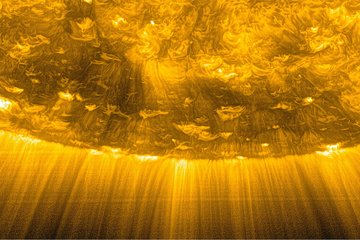All genres
1.
Journal Article
A New Simple Dynamo Model for Stellar Activity Cycle. Astrophysical Journal 824 (2), 67 (2016)
2.
Journal Article
Limits to solar cycle predictability: Cross-equatorial flux plumes. Astronomy and Astrophysics 557, A141 (2013)
3.
Journal Article
Hemispherical Parker waves driven by thermal shear in planetary dynamos. Europhys. Lett. 104 (4), 49001 (2013)
4.
Journal Article
Modeling solar cycles 15 to 21 using a flux transport dynamo. Astronomy and Astrophysics 553, A128 (2013)
5.
Journal Article
Can Surface Flux Transport Account for the Weak Polar Field in Cycle 23? Space Science Reviews 176, pp. 289 - 298 (2013)
6.
Journal Article
Domino model for geomagnetic reversals. Physical Review E 87, 012108 (2013)
7.
Journal Article
Surface flux evolution constraints for flux transport dynamos. Astronomy and Astrophysics 542, A127 (2012)
8.
Journal Article
Stellar Wind Influence on Planetary Dynamos. Astrophysical Journal 750 (2), 133 (2012)
9.
Journal Article
Coupled spin models for magnetic variation of planets and stars. Mon. Not. Roy. Astron. Soc. 423 (4), pp. 2977 - 2990 (2012)
10.
Journal Article
Dynamo action in an ambient field. Astron. Nachrichten 332, pp. 36 - 42 (2011)
11.
Journal Article
Evidence from numerical experiments for a feedback dynamo generating Mercury's magnetic field. Science 334, pp. 1690 - 1693 (2011)
12.
Journal Article
Magnetic flux generation and transport in cool stars. Astronomy and Astrophysics 528, A135 (2011)
13.
Journal Article
The solar magnetic field since 1700 I. Characteristics of sunspot group emergence and reconstruction of the butterfly diagram. Astronomy and Astrophysics 528, A82 (2011)
14.
Journal Article
The solar magnetic field since 1700 II. Physical reconstruction of total, polar and open flux. Astronomy and Astrophysics 528, A83 (2011)
15.
Journal Article
Mode analysis of numerical geodynamo models. Phys. Earth Planet. Inter. 188, pp. 185 - 193 (2011)
16.
Journal Article
Surface flux transport modeling for solar cycles 15-21: effects of cycle-dependent tilt angles of sunspot groups. Astrophysical Journal 719, pp. 264 - 270 (2010)
17.
Journal Article
The initial temporal evolution of a feedback dynamo for Mercury. Geophys. Astrophys. Fluid Dynamics 104, pp. 419 - 429 (2010)
18.
Journal Article
Modeling the Sun's open magnetic flux and the heliospheric current sheet. Astrophysical Journal 709, pp. 301 - 307 (2010)
19.
Journal Article
The effect of activity-related meridional flow modulation on the strength of the solar polar magnetic field. Astrophysical Journal 717, pp. 597 - 602 (2010)
20.
Journal Article
Mesogranular structure in a hydrodynamical simulation. Astronomy and Astrophysics 519, A52 (2010)










